Mag. Aleksander Mervar, the CEO of ELES, dr. Tomaž Štokelj, the CEO of HSE, and dr. Dejan Paravan, the CEO of GEN Energija, are in agreement: The measures taken by the government and energy companies in order to deal with the energy crisis have worked, the situation is under control. However, these difficult conditions are by no means over. We must, collectively at all levels, continue with the measures, as well as with the efficient use of energy. But not only that: in the long term, Slovenia urgently needs investments in new low-carbon production units and renewable energy sources, as the more than 30% average import dependence that marked the year 2022 is completely unacceptable.
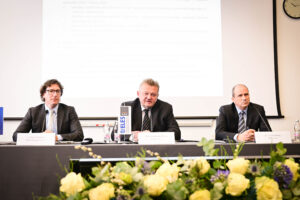
At the meeting on 15. of March 2023, the managements of key energy companies operating in the MOPE crisis group, appointed by the decision of the Government of the Republic of Slovenia on the 14th of July 2022 – ELES, HSE and GEN Energija, shed light on the circumstances affecting current developments in the Slovenian energy market. The fact is that in 2022 we were hit by an energy crisis the likes of which we have never experienced before. The energy industry was marked by strong fluctuations in the prices of energy products, which were the result of several factors: from Russia’s invasion of Ukraine, which, by reducing gas supplies, triggered a high energy price in the entire European area, which is heavily dependent on the import of this fossil energy product, to the simultaneous confrontation with a long-term drought and the resulting low production of hydropower plants.
Practically all EU countries, including Slovenia, have adopted measures to protect consumers and mechanisms to ensure the liquidity of energy companies. At the outset, the speakers agreed that the laws and by-laws passed by the government in the last six months were key to managing the electricity situation. The Slovenian energy companies have also responded with a series of measures and, despite the emergency, are constantly providing an uninterrupted supply of electricity at acceptable and guaranteed prices.
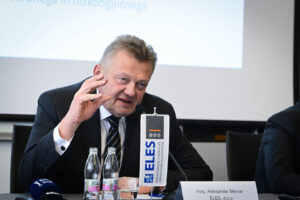
Photo: Mag. Aleksander Mervar, ELES, d.o.o.
The measures taken by the government and the energy companies worked, the situation is under control
- Electricity supply is reliable
In crisis situations, Slovenian energy companies always ensured a reliable supply of electricity despite the outage of their own hydro production due to a record drought and despite the demanding overhaul of the Krško Nuclear Power Plant (NEK) and the saving of coal in the Šoštanj Thermal Power Plant (TEŠ). When NEK and TEŠ 6 were not in operation in October, there were no problems with the supply of electricity in the short term, even though Slovenia was more than 56% dependent on its import at that time. This means that the Slovenian electricity system is robust. However, since we are dependent on neighbouring countries with such large imports, we cannot rely on the fact that the supply will be uninterrupted also in future similar situations.
- Generation is stabilized
At the level of electricity generation, the implementation of these measures enabled the stable and reliable operation of the Krško Nuclear Power Plant, which received permission to extend operation until 2043. The successful rehabilitation of the conditions in the Velenje Coal Plant and the increased use of biomass both enabled the smooth operation of the Šoštanj Thermal Power Plant, as well as the upgrading of the Thermal Power Plant Brestanica (TEB) with oil derivatives for replacing the natural gas that powers it. Including all of the above, energy companies also continued to invest in renewable energy sources.
- The consumption of electricity is lower by 6.6 percent
Electricity consumption was mainly reduced by business customers – by a total of 10.9 percent. Most of them were large clients connected to the transmission network. The total growth of consumption, by 4.4 percent, was recorded only among household customers and public institutions. Compared to the pre-coronavirus year of 2019, the total consumption was 6.6 percent lower. That it is indeed possible to achieve a reduction in consumption in this segment as well, with appropriate engagement, was demonstrated by GEN-I, where they urged household customers to save with the campaign “From Less to More”. From the beginning of October to the end of December 2022, GEN-I household customers reduced their consumption of electricity by 3 percent and natural gas by 22 percent, compared to the same period in 2021. GEN-I gave them a total discount of approximately one million euros for the energy saved on their February bills.
- Prices are affordable and comparable to other EU countries
Final electricity prices for household customers in Slovenia in 2022 were the second lowest compared to neighbouring countries, right after Hungary. The same applies to business customers, where final prices were lower only in Croatia. In 2021, for the 100 largest consumers of electricity in Slovenia, the cost of electricity accounted for 1.7 percent of the total revenue from operations. For 2022, according to Mervar’s estimate, this share will not exceed 2.1 percent.
- The liquidity of key energy companies in the country is stable, credits are returning
In order to ensure the liquidity of energy companies, the state adopted a law of suretyship in September, within the framework of which the Holding Slovenske elektrarne (HSE) took out a short-term loan for 185 million euros, which is no longer used. In addition, in the coming months, they will begin returning the first 200 of the 492 million euros from the subsequent payment of capital, which they received from the state in December 2022 in order to bridge the extraordinary liquidity situation. GEN also took out short-term loans with a state guarantee in the total amount of 100 million euros in order to bridge liquidity burdens related to the purchase of replacement electricity during the overhaul of the Krško Nuclear Power Plant. The last instalment of the loan, EUR 10 million, was returned by GEN at the beginning of March.
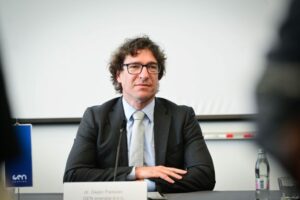
Photo: Dr. Dejan Paravan, GEN energija, d.o.o.
Market conditions and prospects for the coming year
Energy companies are looking forward to the future with optimism, although according to dr. Paravan, the energy crisis is not over yet. That is why we must continue to implement measures to deal with the crisis, including those for the efficient use of energy, which came into force last year. “Electricity prices are currently lower than the regulated prices in practically all consumption segments, which is primarily a reflection of the drop in prices on the wholesale market from the beginning of the year to today. But the situation on the energy market remains tight. There is still a shortage of about 20 percent of gas supply in Europe, so there is still a possible gas shortage in 2024 and 2025, which will keep pressure on energy prices. We therefore urge business customers to take advantage of the current situation in order to carry out a partial purchase of energy for several years in advance. The recommendation is at least 25 percent for the next three years, 2024, 2025 and 2026“, stressed dr. Paravan.
Mag. Mervar also emphasized that the energy industry is preparing for the coming winter: “We were very lucky this winter because of the high average temperatures. The situation could be completely different if we had low average temperatures, as wholesale prices would be higher.” According to Mervar’s assessment, Slovenia is extremely exposed in the field of reliable electricity supply in case of crisis situations, the relatively favourable development of events in recent months does not allow for complacency. Without new investments, this exposure will only increase, not only in the area of supply, but also in the area of prices.
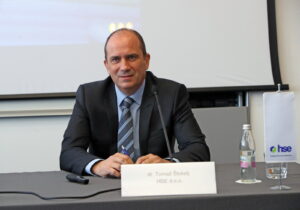
Photo: Dr. Tomaž Štokelj, HSE d.o.o.
Decisive measures are necessary to ensure a long-term self-sufficient as well as low-carbon electricity system
The energy crisis exposed Slovenia’s high dependence on imported electricity, which reached an average of 32.6 percent in 2022, with 98.3 percent of all hours of the year being imported electricity. Similarly, in the first two months of this year, the average import dependency was 31 percent. This is unacceptable from the point of view of national security of energy supply and the sovereignty of the country. We have been warning the energy industry about this problem for a long time and we are in agreement that a serious industrially developed country like Slovenia cannot afford such a large import dependency.
In the coming years, without the start of an intensive investment cycle, the large gap between the consumption and production of electricity will only increase. Therefore, Slovenia must focus all its efforts on establishing a self-sufficient and low-carbon electricity system, which means urgent investments in new production units. “Without the necessary investments, we are in danger of being between 40 and 50 percent dependent on imports by 2030 on average. The higher the import dependence, the more the wholesale prices of electricity will be correlated with the prices on the European stock exchanges, additionally increased for the costs of cross-border capacities, the greater the risk for Slovenia in terms of sufficient supply of electricity in the event of crisis situations in the EU and Europe!” illustrated mag. Mervar.
Dr. Štokelj described the situation on the wholesale markets and emphasized that investments in carbon-free and low-carbon technologies are necessary in order to ensure reliable and price-variable supply of Slovenian customers. Both energy pillars are intensively preparing for accelerated investments in renewable energy sources. Both HSE and GEN emphasize that it is time for a green transformation, development and investment in environmentally friendly technologies, opportunities are also offered in the field of offering flexibility and energy storage. The HSE Group is already the largest producer of electricity from renewable sources in Slovenia, and it is preparing for decarbonization and the construction of alternative and additional carbon-free production sources. “We have set ourselves an ambitious investment program that includes both large solar and wind power plants as well as the renovation of existing hydroelectric power plants and the construction of hydroelectric power plants on the middle Sava River. The HSE Group intends to realize its vision of being the carrier of the green transition in Slovenia also by exploiting geothermal energy, biomass and investing in hydrogen technologies,” stressed dr. Tomaž Štokelj, the CEO of HSE.
In the GEN Group, where electricity production is already 99% low-carbon, the central development project of national importance will be the construction of a second nuclear power plant (JEK2). “We will do everything in our power to make the project progress as quickly as possible, thus responding to the need for energy independence and the expected lack of electricity in the next decade,” concluded dr. Paravan.
The system operator is preparing to modernize the transmission and especially the distribution system.
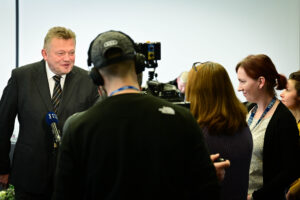
The video of the event: